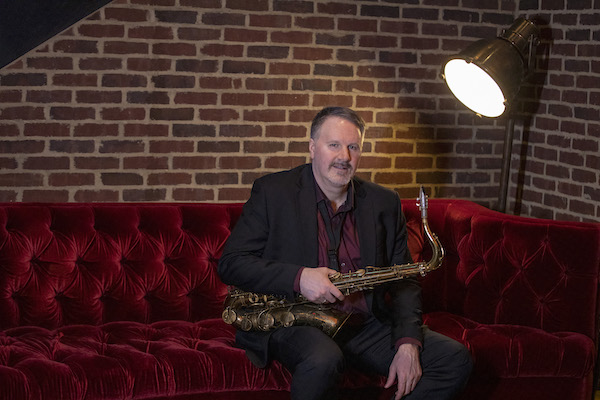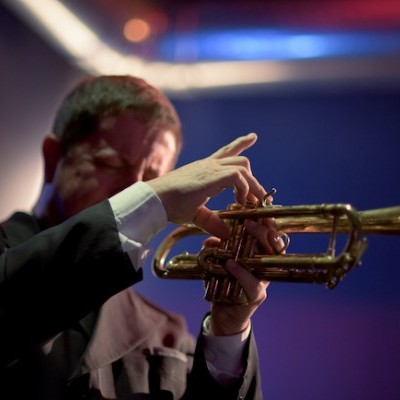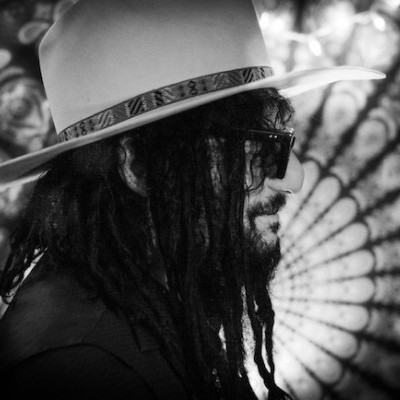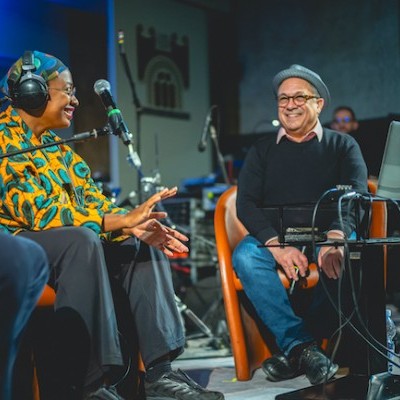Jul 9, 2024 11:35 AM
Trumpeter, Educator Jim Rotondi Dies at 61
Jim Rotondi, a renowned hard-bop trumpeter, composer and educator, died suddenly on July 7 at a hospital in France. He…

Saxophonist Russ Nolan’s new album is titled Sin Fronteras.
(Photo: Blaga Ditrow/Lush Life Film)The origin story of saxophonist Russ Nolan’s new album, the Pan-American-oriented Sin Fronteras, dates to 2007, five years after he moved from Chicago to Queens. Nolan—who had earned a black belt in taekwondo—retired from that practice because, he said, “The danger of hurting myself for good was great.” Looking for another physical activity, he decided to take up salsa dancing.
Early in the process, Nolan took lessons three nights a week from Eddie Torres (aka “The Mambo King”), a “melodic dancer” whose sage advice on “telling a story, phrases, breathing and using space” broadened his rhythmic palette. Meanwhile, Nolan spent quality time at the popular Jackson Heights venue Terraza 7, whose owner had cultivated a number of traditional dance styles. Around 2010, he became friendly with Colombian drummer Juan Felipe Mayorga, a recent emigrant who was moonlighting as the room’s bartender.
“Juan had the keys to Terraza 7 during the day, and we started calling sessions,” said Nolan, who was already exploring possibilities of fusing Afro-Caribbean rhythms with post-bop harmony in groups with pianists Manuel Valera and Michael Eckroth.
Eventually, in 2016, Nolan and Mayorga began weekly midday rehearsals there with Swiss pianist Manu Koch and Bulgarian bassist Trifon Dimitrov. Nolan used the sessions as opportunities to further coalesce his investigations into transmuting various south-of-the-border rhythmic structures into musical narrative.
How these encounters bore fruit is apparent throughout Sin Fronteras, a collection of 10 tunes written or arranged by Nolan. The band incorporates metrically modulating beats culled from various sources, including Puerto Rican plena (“The Long Ranger”), Spanish bulería (“Nature Boy”), Afro-Peruvian festejo (“Somewhat Festive”), Afro-Cuban abakuá (“Chachalokafun”), rumba (“Cruzado”) and bossa (“Nublado Y Claro”). Throughout the program, Nolan uncorks melodic, across-the-barline improvisations on tenor and soprano saxophones.
“Russ is always researching, always writing,” said Mayorga, who plays on the album alongside Dimitrov and Koch. “Russ never stops if something isn’t familiar—he just does it. He’ll present a tune with a rhythm I don’t know a lot about, so I do some research to make it more traditional. Perhaps the interpretations don’t show precisely how a specific style is played, but I don’t think it matters. We’re trying to have a basic understanding, with some of our own fingerprints.”
A son of Gurnee, Illinois, Nolan ascribes his can-do persistence to his father (“a quietly motivated cancer researcher who always stayed in the lab trying to find cures”) and his no-nonsense mother (“one of 13 from a North Dakota farm family, so there wasn’t a lot of talk about ‘How am I feeling?’”).
“I could certainly get down and depressed about aspects of the music business, but life is short, and I can’t spend another minute being negative,” Nolan said in late February, the day before a high-octane happy-hour show with organist Pat Bianchi at the Marriott Vacation Club Pulse hotel in Midtown. “In the end, it’s the joy it brings me. If I can share that joy, I think I’ve done my job as a human being.”
In an email exchange with DownBeat in early April, Nolan explained how, during the coronavirus lockdown, he had been using video conference calls to provide instruction to the adult musicians who normally study with him in person at JazzLabNY, the music education company he founded.
Despite the economic hurdles presented by the complete halt of his live performances, Nolan remained optimistic.
“Musicians—and many other professions—must continually reinvent themselves, reassess their strengths, be honest about what they are willing and unwilling to do, and make serving other people with their music a priority,” he said. “Find a need and fill it.” DB
This story originally was published in the July 2020 issue of DownBeat. Subscribe here.

Jim Rotondi was acclaimed for his wide, round trumpet tone, remarkable virtuosity and assured swing.
Jul 9, 2024 11:35 AM
Jim Rotondi, a renowned hard-bop trumpeter, composer and educator, died suddenly on July 7 at a hospital in France. He…

Charles Lloyd, seen here at the 2024 New Orleans Jazz & Heritage Festival, makes DownBeat Poll history!
Jul 11, 2024 12:23 PM
The incomparable Charles Lloyd swept the 72nd Annual DownBeat Critics Poll, becoming the first artist ever to earn…

“Being president of Blue Note has been one of the coolest things that ever happened to me,” Was said. “It’s a gas to serve as one of the caretakers of that legacy.”
Jun 4, 2024 12:21 PM
Sitting with Don Was is a comfortable and unhurried exercise. He may seem slightly reserved at first, but ideas and…

“She reminds me of my childhood and makes we want to cry,” Cécile McLorin Salvant, pictured here with writer Ashley Kahn, said of Dianne Reeves.
Jun 11, 2024 12:31 PM
Italy’s Umbria Jazz Winter is one of those rare annual festivals that not only coincides with a major holiday —…

Maria Schneider said of Decades, her new compilation release: “I just wanted to create something, put it in a beautiful box and say, ‘Look at what we did.‘”
Jun 18, 2024 12:00 PM
Maria Schneider opened the sleek black box and placed it on a coffee table in her Manhattan apartment. Inside lay the…